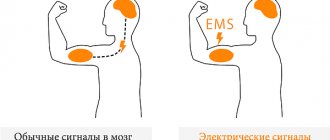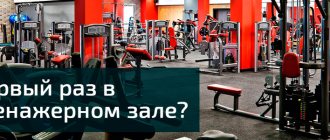The topic on the agenda is load characteristics. Watching videos on the Internet and reading articles about bodybuilding, you can often notice errors in wording, even among experienced athletes. We are talking, as you understand, about such concepts as intensity and volume of training.
We will look in detail at how load is characterized and what intensity and volume are when it comes to training. Training loads are defined by the following concepts:
- »Value
- »Duration
- "Intensity
- "Volume
- » Workout size
Training Amount
The value is the total load on the body that you and I gave it during training. That is, when the load is not on a specific system, for example, a muscular one, but also on the central nervous system, immune system, microdamage to tissue, and so on.
The load will increase if we replace isolation exercises with basic ones. In this case, the load on the entire body will be greater, the stress will be stronger. You can estimate the amount of load based on your own feelings, giving an assessment of your training and fatigue after it from 1 to 10 points.
With one point we feel as if we haven’t trained, and with 10 points we can barely crawl out of the gym and can’t stand on our feet, which is clearly not good, unless of course we are talking about shock training.
Volume of strength training
Weightlifters measure their strength training volume in tons. They multiply not only sets and repetitions, but also kilograms of barbells, thus obtaining tons of iron that they lift in training.
Such a complex method of accounting for strength training is justified if the goal of competition training is one-repetition maximum.
The size/quarter technique is a natural bodybuilding technique that only considers the total number of repetitions for a given number of sets.
To track muscle growth, we just need to know the number of repetitions per set and the number of approaches per week.
training program
Duration of load
Combined with the fixed intensity of our workout, the duration of the load determines the magnitude of the load and its direction. In the case of developing flexibility or endurance, the duration of the load will be measured in minutes. In the case of robots with weights - during the time the muscles work under load.
But since when performing an approach we are also not able to record the time of work, then to simplify the duration of the load when working with a robot with iron, it is measured by the number of repetitions.
Load intensity
Load intensity is measured by power. The more power an athlete develops, the more intense his workout will be. For ease of understanding, we have highlighted our definition of load intensity.
By load intensity we mean how intensely our brain needs to send impulses to the motor neurons (target muscle). That is, the heavier the weight of the projectile, for example, work for 1 or 2 repetitions, the greater the intensity compared to work in more repetitions and with lighter weights. A striking example of high intensity work would be powerlifting and weightlifting competitions.
Intensity of physical activity[edit | edit code]
Yuzhakov Anton Methods for increasing the intensity of training in bodybuilding
Read a similar article:
Intensity of strength training
Training intensity
depends on working weight or percentage of repetition maximum (RM):
- Low intensity training - 10-40%RM
- Moderate intensity workouts - 40-80%RM
- High intensity training - 80-100%RM.
In a broader sense, training intensity or training load is the amount of energy expended per unit of time (per workout or cycle). In bodybuilding, this can be determined by the following factors:
- volume - for example, an athlete performs squats with a weight of 80 kg 10 times in 5 approaches. The load volume in one approach will be: 80 kg X 10 = 800 kg.
- working weight
- number of repetitions
- tempo or speed of exercise
- rest between sets
- range of motion
Load volume
The volume of load is related to the amount of energy expended to overcome external force, for example, during mechanical work. Working with a barbell weighing 80 kg. with 15 repetitions it will be more voluminous than working with a 120 kg barbell. in 6 repetitions. More voluminous, but less intense, since the amount of energy expended is greater, and the intensity of the impulses necessary to overcome the weight of the projectile is less.
In resistance training, the volume of load is often expressed in terms of tonnage. Tonnage is the total weight of the weights taken for training or exercise. A striking example of maximum volume work would be marathon competitions.
Let us note that in our training we work either intensively or more extensively, depending on the tasks set. Training at the same time as intensely and as volumetrically as possible is only allowed during a short period of impact training. Otherwise, we will be overtired or overtrained.
Let's look at the moments at which the intensity and volume of our training increases.
Features of training frequency
Despite the fact that you already know what optimal frequency you need to train depending on your goal (muscle growth, strength, endurance) and level of training, there are some restrictions and deviations from the usual training process that must be taken into account if you want to train effectively and safe .
With muscle overtraining
Loss of energy for training, deterioration in sports performance, physical fitness, and sometimes banal motivation to train, all this is associated with overtraining , that is, a state of the body in which stress (emotional, psychological or physical) exceeds recovery abilities.
As one of the measures to prevent/treat overtraining, infrequent training is used, that is, is reduced .
For example, in your usual training regime you do only 3-4 workouts a week, and one “wonderful” day you feel that you don’t have the strength to train, and no energy drinks (we’re talking about pre-workout complexes) and extra sleep on 1- 2 hours doesn't help. In this case, we recommend that you add 1-2 days of rest between workouts - sometimes this method helps prevent overtraining (especially at the initial stage of its development).
Training frequency and muscle overtraining
But what to do with your training program if your overtraining is in an advanced stage? The answer is extremely simple - wait for time, take a break from the training process (usually 2-3 weeks of rest help the body recover from “overtraining”).
On a chemical course of steroids
Training on anabolic steroids differs primarily from natural training in that it can be carried out more often and more rigorously , due to the accelerated recovery of the body.
Testosterone is a male sex hormone that has a powerful anabolic effect, under the influence of which, provided that you train in a strength style, muscle mass and strength begin to quickly respond to the load. So, if you are on a “ steroid cycle ,” then recovery occurs much faster, and training can be done more often, for example, training up to 5-6 times a week , without fear of overtraining. And that is why all the advice from professional bodybuilders , as well as their training schemes, do not work on “naturals”; they cannot perform the crazy training volume that chemical bodybuilders , not to mention the fact that their systems are far from ideal and in In fact, they only work effectively on athletes taking anabolic steroids.
The effect of anabolic steroids on training frequency
At home
If you create conditions at home for full-fledged training (strength or cardio), then they will be no different from training in the gym. At the same time, the frequency of the training process will remain the same.
The main problem of all home workouts is creating optimal conditions:
- purchase of training equipment (bench, racks, mats, horizontal bar, barbell, dumbbells, etc.)
- availability of a spacious, free room
- creating a special atmosphere (turning on music, sticking motivational posters on the wall)
Features of the frequency of training at home
And of course, we must not forget that neighbors and equipment will have to be placed carefully under you, not to mention the fact that you may be distracted from the training process by ordinary household chores .
Due to the above-mentioned non-objective reasons for skipping/reducing training time, your frequency and effectiveness of home training may decrease.
But if you are confident that you can create comfortable conditions for training at home, then feel free to start implementing them, while maintaining the training frequency recommended below, depending on your goal.
Training intensity and volume
The intensity increases with:
- »Increasing the weight of the weight and decreasing the number of repetitions
- » Approaching the failure state in the last repetitions of the sets
- »Reducing the pause between sets
- »Increasing driving speed
Volume increases when:
- »Increasing weight without decreasing the number of repetitions
- »Increasing the number of repetitions in a separate approach
- »Increasing the number of approaches per exercise
- »Increasing the number of exercises in your workout
Tags: workout intensity, workout volume, workout duration, workout size
Author: ForceMan from 08/18/2015, 07:26
- 3
Increasing training volume
In the size/quarter method, the minimum training volume is 15 approaches per exercise per week. This is 3 workouts per exercise, 5 sets each.
For example, if you can do 10 push-ups, then you need to do 3 workouts. For each workout you need to do 5 sets of 7 repetitions.
The exercise can be done 3-5 times a week. But if you are used to doing 3 workouts a week, then you can’t decide to do 5 workouts a week on Monday.
In the size/quarter method there is a 10% rule, which says that the load can be increased by no more than 10% per week.
If you are used to doing 15 approaches per week, then you need to increase the volume of training by no more than one approach per week.
For example, if you did 3 workouts a week of 5 sets, then you can do 2 workouts of 5 sets and one workout of 6 sets.
training program











